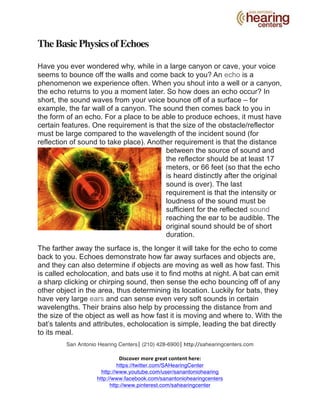
The Basic Physics of Echoes
- 1. The Basic Physics of Echoes Have you ever wondered why, while in a large canyon or cave, your voice seems to bounce off the walls and come back to you? An echo is a phenomenon we experience often. When you shout into a well or a canyon, the echo returns to you a moment later. So how does an echo occur? In short, the sound waves from your voice bounce off of a surface – for example, the far wall of a canyon. The sound then comes back to you in the form of an echo. For a place to be able to produce echoes, it must have certain features. One requirement is that the size of the obstacle/reflector must be large compared to the wavelength of the incident sound (for reflection of sound to take place). Another requirement is that the distance The farther away the surface is, the longer it will take for the echo to come back to you. Echoes demonstrate how far away surfaces and objects are, and they can also determine if objects are moving as well as how fast. This is called echolocation, and bats use it to find moths at night. A bat can emit a sharp clicking or chirping sound, then sense the echo bouncing off of any other object in the area, thus determining its location. Luckily for bats, they have very large ears and can sense even very soft sounds in certain wavelengths. Their brains also help by processing the distance from and the size of the object as well as how fast it is moving and where to. With the bat’s talents and attributes, echolocation is simple, leading the bat directly to its meal. San Antonio Hearing Centers| between the source of sound and the reflector should be at least 17 meters, or 66 feet (so that the echo is heard distinctly after the original sound is over). The last requirement is that the intensity or loudness of the sound must be sufficient for the reflected sound reaching the ear to be audible. The original sound should be of short duration. (210) 428-6900| http://sahearingcenters.com Discover more great content here: https://twitter.com/SAHearingCenter http://www.youtube.com/user/sanantoniohearing http://www.facebook.com/sanantoniohearingcenters http://www.pinterest.com/sahearingcenter
- 2. The dolphin is another mammal who uses echolocation. The dolphin has a structure in its head called the phonic (or sonic) lips. Humans, like nearly all mammals, produce sounds using their vocal cords. The dolphin doesn’t have vocal cords, but instead developed its phonic lips from what was once the dolphin’s nose. By sending pressurized air past these lip-like structures, the air vibrates and click sounds are produced. When the clicks bounce off of the object the dolphin is interested in (that is, when the echo occurs) the dolphin then gets a mental picture of that object. San Antonio Hearing Centers| (210) 428-6900| http://sahearingcenters.com Discover more great content here: https://twitter.com/SAHearingCenter http://www.youtube.com/user/sanantoniohearing http://www.facebook.com/sanantoniohearingcenters http://www.pinterest.com/sahearingcenter
